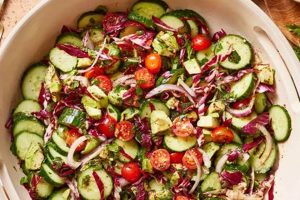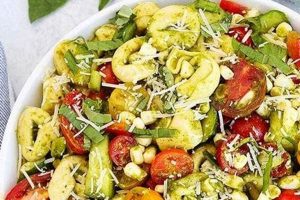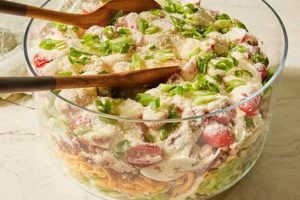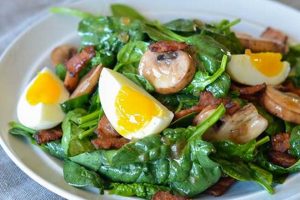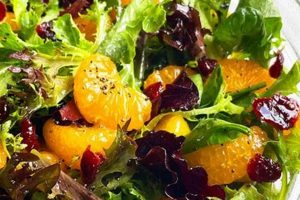A superior panzanella relies on high-quality ingredients and a thoughtful approach to construction. Stale, crusty bread is essential, providing a sturdy base to absorb the flavorful juices of ripe tomatoes, crisp cucumbers, and other fresh vegetables. A vibrant vinaigrette, often incorporating red wine vinegar, olive oil, and aromatic herbs, binds the elements together. Variations may include additions such as capers, onions, anchovies, or bell peppers, showcasing the adaptability of this Tuscan classic.
This salad’s strength lies in its resourcefulness, transforming day-old bread into a culinary centerpiece. The interplay of textures, from the softened bread to the crunchy vegetables, offers a delightful sensory experience. Historically, panzanella served as a practical way to utilize leftover bread, highlighting the ingenuity of peasant cuisine. Its enduring popularity speaks to its refreshing simplicity and satisfying flavors, making it a welcome addition to warm-weather meals or a light yet substantial lunch.
The following sections will delve into specific ingredient selections, techniques for achieving optimal bread texture, and variations on the classic recipe, providing a comprehensive guide to crafting an exceptional panzanella.
Tips for an Exceptional Panzanella
Achieving panzanella perfection hinges on careful attention to detail. These tips offer guidance for elevating this simple salad to new heights.
Tip 1: Bread Selection is Paramount: Opt for a rustic, crusty loaf, such as ciabatta, sourdough, or Tuscan bread. Avoid overly soft breads, which will disintegrate when soaked.
Tip 2: Embrace the Stale: Day-old bread is ideal. Its drier texture absorbs the dressing without becoming mushy. Fresh bread can be toasted or dried in a low oven to achieve the desired consistency.
Tip 3: Proper Soaking Technique: Tear the bread into bite-sized pieces and toss gently with a portion of the vinaigrette. Allow the bread to soak for 15-20 minutes, ensuring it absorbs the flavors while retaining some texture.
Tip 4: Tomato Selection Matters: Ripe, flavorful tomatoes are key. Heirloom varieties offer a range of colors and sweetness. Remove excess seeds and juice to prevent the salad from becoming watery.
Tip 5: Balance of Flavors: The vinaigrette should be tangy and vibrant, complementing the sweetness of the tomatoes and the earthiness of the bread. Red wine vinegar, high-quality olive oil, and a touch of Dijon mustard create a balanced foundation.
Tip 6: Fresh Herbs Enhance the Profile: Basil, oregano, and mint are classic additions. Freshly torn herbs offer the most vibrant flavor.
Tip 7: Consider Complementary Ingredients: Capers, red onion, cucumbers, and bell peppers add textural and flavor complexity. Anchovies or olives provide a salty, briny element.
By adhering to these guidelines, one can create a panzanella that showcases the harmonious interplay of flavors and textures, transforming humble ingredients into a culinary masterpiece.
The following section will offer a complete recipe incorporating these tips, ensuring a successful and satisfying panzanella experience.
1. High-Quality Olive Oil
High-quality olive oil plays a crucial role in achieving an exceptional panzanella. The olive oil is not merely a medium for the vinaigrette; it contributes significantly to the overall flavor profile and textural experience. A robust, extra virgin olive oil, preferably cold-pressed, imparts a distinct fruitiness and peppery finish that complements the sweetness of ripe tomatoes and the tanginess of the vinegar. Its viscosity also coats the bread and vegetables, creating a luxurious mouthfeel.
Consider the difference between using a generic, refined olive oil versus a high-quality extra virgin olive oil. The generic oil often lacks depth of flavor, offering little more than a greasy texture. Conversely, a high-quality extra virgin olive oil, such as a Tuscan or Ligurian oil, adds a nuanced layer of fruitiness and complexity, elevating the salad from simple to sublime. For instance, a peppery Tuscan olive oil harmonizes beautifully with the acidic notes of the vinaigrette and the sweetness of ripe tomatoes, creating a balanced and harmonious flavor profile. A smoother, fruitier Ligurian oil might offer a different, yet equally compelling, dimension to the salad.
Understanding the impact of olive oil quality on the final product is essential for crafting a truly exceptional panzanella. Investing in a high-quality extra virgin olive oil transforms the salad, enhancing both its flavor and textural complexity. This seemingly small detail distinguishes a mediocre panzanella from a truly memorable culinary experience. Selecting the right olive oil, therefore, represents a critical step in achieving panzanella perfection.
2. Ripe, Flavorful Tomatoes
The quality of tomatoes significantly impacts the overall success of a panzanella salad. Ripe, flavorful tomatoes provide the essential sweetness and juiciness that balance the other components. Underripe or bland tomatoes result in a lackluster salad, failing to provide the necessary contrast to the acidic vinaigrette and the savory bread. The inherent sweetness of ripe tomatoes also contributes to the overall complexity of the dish, creating a harmonious interplay of flavors. Consider the difference between a panzanella made with out-of-season, supermarket tomatoes versus one utilizing locally sourced, vine-ripened heirloom varieties. The latter offers a depth of flavor and sweetness often absent in commercially produced tomatoes. This distinction significantly impacts the final product, demonstrating the crucial role of tomato selection in achieving a truly exceptional panzanella. For example, using a variety like Brandywine, known for its balanced sweetness and acidity, provides a more complex flavor profile than a standard grocery store tomato.
The texture of the tomatoes also plays a role. While ripe tomatoes should be juicy, excessive moisture can lead to a soggy salad. Choosing tomatoes with firm flesh, such as Roma or San Marzano, helps maintain the structural integrity of the salad while still providing ample juice and flavor. These varieties offer a robust texture that holds up well when combined with the bread and vinaigrette. Furthermore, the choice of tomato variety can influence the salad’s visual appeal. Heirloom tomatoes, with their vibrant colors and varied shapes, add an element of visual interest, transforming the panzanella into a feast for both the eyes and the palate. This visual appeal enhances the dining experience, further highlighting the importance of careful tomato selection.
Therefore, selecting ripe, flavorful tomatoes is paramount to crafting a truly exceptional panzanella. The tomatoes’ inherent sweetness, juiciness, and texture directly influence the salad’s overall balance and complexity. Prioritizing quality in tomato selection elevates the panzanella from a simple bread salad to a vibrant and satisfying culinary experience. Overlooking this crucial element risks compromising the delicate balance of flavors and textures that define a truly great panzanella.
3. Stale, Crusty Bread
Stale, crusty bread forms the foundation of a successful panzanella salad. Its texture is crucial, offering a desirable contrast to the juicy tomatoes and other fresh ingredients. Unlike fresh bread, which tends to become soggy and lose its structural integrity when dressed, stale bread possesses the ideal absorbency to soak up the vinaigrette while maintaining a pleasant chewiness. This characteristic distinguishes panzanella from an ordinary salad, transforming it into a unique culinary experience.
- Absorbency and Texture
The stale bread’s porous nature allows it to absorb the vinaigrette’s flavors, becoming infused with the tangy notes of vinegar, the richness of olive oil, and the aromatic essence of herbs. This absorption is key to preventing a watery salad and ensures that each bite is infused with flavor. Examples of suitable bread types include ciabatta, sourdough, and Tuscan bread. Their open crumb structure and firm crust provide the perfect balance of absorbency and texture. Conversely, soft breads like sandwich loaves lack the necessary structure and become mushy when dressed.
- Flavor Enhancement
While seemingly a neutral base, stale bread contributes a subtle, yet essential, nutty flavor to the panzanella. This nuanced flavor develops as the bread dries, further enhancing the overall complexity of the salad. The slight toastiness of the bread also complements the fresh vegetables and herbs. For example, a day-old sourdough loaf offers subtle tangy notes that harmonize with the vinaigrette’s acidity.
- Preventing Sogginess
The drier nature of stale bread prevents the salad from becoming overly saturated and soggy, a common pitfall when using fresh bread. This allows the other ingredients to shine without being overwhelmed by excess moisture. Consider the difference between adding croutons to a traditional salad versus the substantial bread pieces in panzanella. Croutons quickly lose their crispness, while the larger, stale bread pieces in panzanella retain their pleasant chewiness, providing a more satisfying textural experience.
- Historical Significance
The use of stale bread in panzanella reflects the resourcefulness of traditional Tuscan cuisine. Historically, this salad served as a means of utilizing leftover bread, preventing food waste. This practical approach not only minimizes waste but also highlights the ingenuity of transforming humble ingredients into a flavorful and satisfying dish. This historical context adds depth to the appreciation of panzanella as more than just a salad; it represents a culinary tradition rooted in resourcefulness and respect for ingredients.
The selection of stale, crusty bread, therefore, goes beyond mere convenience; it is integral to the very essence of panzanella. It is the structural and flavorful backbone upon which the other ingredients build, ultimately determining the salad’s success. By understanding the role of stale bread, one can fully appreciate the nuanced complexities of this seemingly simple, yet deeply satisfying, Tuscan classic.
4. Balanced Vinaigrette
A balanced vinaigrette constitutes a critical element in crafting a superlative panzanella salad. The vinaigrette’s role extends beyond simply dressing the ingredients; it serves as a unifying force, harmonizing the diverse flavors and textures. An overly acidic vinaigrette overwhelms the delicate sweetness of the tomatoes and other vegetables, while a bland dressing fails to provide the necessary contrast and depth. Balance hinges on the careful interplay of acidity, sweetness, and oil. Classic panzanella vinaigrettes often feature red wine vinegar for its robust tang, but balsamic or white wine vinegar can offer nuanced variations. A touch of sweetness, derived from a pinch of sugar or a drizzle of honey, tempers the acidity, preventing harshness. High-quality olive oil provides richness and body, coating the ingredients and contributing to a luxurious mouthfeel. Consider the difference between a vinaigrette made with only vinegar and oil compared to one incorporating a touch of Dijon mustard or minced shallot. These additions introduce complexity, enhancing the overall flavor profile and contributing to a more balanced and nuanced final product. The vinaigrette’s balance directly impacts the overall enjoyment of the panzanella, transforming it from a simple bread salad into a cohesive and flavorful culinary experience.
Achieving the ideal balance requires careful consideration of the other ingredients. The sweetness of ripe tomatoes, for example, necessitates a vinaigrette with sufficient acidity to cut through the richness. If other ingredients, such as olives or capers, introduce saltiness, the vinaigrette may require less vinegar to maintain equilibrium. The quantity of vinaigrette also matters. Too much dressing results in soggy bread, while too little leaves the salad dry and unbalanced. The bread’s absorbency should be taken into account, as different bread types require varying amounts of dressing to achieve optimal saturation. Practical experimentation is often necessary to achieve the perfect balance for a specific recipe, highlighting the dynamic interplay between the vinaigrette and the other components of the salad. For instance, a panzanella featuring salty anchovies and olives benefits from a less acidic vinaigrette, allowing the briny flavors of the additions to shine without being overwhelmed by vinegar. Conversely, a panzanella highlighting sweet cherry tomatoes and bell peppers requires a more pronounced acidity to cut through the sweetness and achieve a harmonious balance.
In summary, the significance of a balanced vinaigrette in a panzanella salad cannot be overstated. It serves as the unifying element, bringing together the diverse flavors and textures into a harmonious whole. Careful consideration of the vinaigrette’s acidity, sweetness, and oil content, in conjunction with the characteristics of the other ingredients, is essential for achieving a truly exceptional panzanella. Mastering this balance elevates the salad from a simple combination of ingredients to a sophisticated and satisfying culinary creation. Ignoring this critical element risks compromising the overall flavor profile and diminishes the potential for a truly memorable dining experience.
5. Fresh, Aromatic Herbs
Fresh, aromatic herbs constitute an essential element in elevating panzanella salad from simple to exceptional. Their contribution extends beyond mere garnish; they infuse the salad with vibrant flavor and aromatic complexity, playing a crucial role in balancing the other components. The careful selection and application of herbs significantly impact the final product, transforming the sensory experience.
- Flavor Enhancement
Fresh herbs contribute a bright, vibrant flavor dimension that complements the other ingredients. Basil, with its sweet, peppery notes, provides a classic pairing with ripe tomatoes. Oregano offers a more pungent, earthy aroma, while mint introduces a refreshing coolness. The interplay of these flavors creates a dynamic and complex taste profile. For instance, the peppery bite of basil enhances the sweetness of tomatoes, while the earthiness of oregano complements the olive oil’s richness.
- Aromatic Complexity
The aromatic oils present in fresh herbs release their fragrance when torn or chopped, infusing the salad with an invigorating aroma. This aromatic dimension enhances the overall sensory experience, adding another layer of enjoyment. The subtle aroma of mint, for example, adds a refreshing element that complements the other ingredients without overpowering them. The combination of basil, oregano, and mint creates a complex aromatic tapestry that elevates the dining experience.
- Visual Appeal
Fresh herbs contribute not only to the flavor and aroma but also to the visual appeal of the panzanella. Their vibrant green hues contrast beautifully with the deep reds of the tomatoes and the golden tones of the bread, creating a visually enticing presentation. The strategic placement of whole herb leaves as a garnish further enhances the aesthetic appeal, transforming the salad into a feast for the eyes. This visual element contributes significantly to the overall enjoyment of the dish.
- Balancing Flavors
Fresh herbs contribute to the overall balance of the salad, tempering the richness of the olive oil and the acidity of the vinaigrette. Their herbaceous notes provide a counterpoint to the other flavors, preventing any single element from dominating. For instance, the refreshing coolness of mint helps balance the richness of the olive oil, creating a harmonious flavor profile.
In conclusion, the inclusion of fresh, aromatic herbs is paramount in achieving a truly exceptional panzanella salad. Their contribution extends beyond mere garnish, significantly impacting the flavor, aroma, visual appeal, and overall balance of the dish. Careful selection and application of these herbs elevate the panzanella from a simple bread salad to a vibrant and multi-sensory culinary experience.
6. Optimal Bread Soaking
Optimal bread soaking represents a critical step in achieving panzanella perfection. The bread’s texture, a defining characteristic of this Tuscan salad, hinges on the proper absorption of the vinaigrette. Insufficient soaking results in dry, unyielding bread, while excessive soaking produces a soggy, unappetizing mess. Mastering this delicate balance is essential for creating a panzanella that showcases the harmonious interplay of textures and flavors.
- Timing and Technique
The duration and method of bread soaking significantly influence the final outcome. Generally, 15-20 minutes of soaking allows the bread to absorb sufficient vinaigrette without becoming overly saturated. Tearing the bread into bite-sized pieces, rather than cubing it, creates more surface area for absorption, ensuring even distribution of the vinaigrette. Furthermore, gently tossing the bread with the vinaigrette, as opposed to simply pouring it over, promotes even coating and prevents localized sogginess. This careful attention to technique ensures a consistent texture throughout the salad.
- Bread Type Considerations
Different bread types exhibit varying absorption rates. Denser breads, such as sourdough or ciabatta, require slightly longer soaking times compared to lighter breads. The crust’s thickness also plays a role; thicker crusts absorb less liquid than thinner ones. Understanding these variations allows for adjustments in soaking time to achieve the desired texture for a specific bread type. For instance, a dense, crusty sourdough loaf may benefit from a 20-minute soak, while a lighter ciabatta might require only 15 minutes.
- Vinaigrette Viscosity
The vinaigrette’s viscosity influences the bread’s absorption rate. A thicker vinaigrette, perhaps one emulsified with a touch of mustard, clings more readily to the bread, requiring less soaking time. A thinner vinaigrette, on the other hand, requires a slightly longer soak to achieve the same level of saturation. Considering the vinaigrette’s consistency allows for adjustments in soaking time, ensuring optimal bread texture.
- Impact on Flavor Distribution
Optimal bread soaking ensures even distribution of the vinaigrette’s flavors throughout the salad. The bread acts as a flavor carrier, absorbing the tangy vinegar, the rich olive oil, and the aromatic herbs. Proper soaking ensures that each bite contains a balanced blend of these flavors, contributing to the overall harmony of the dish. Uneven soaking, conversely, leads to pockets of intense flavor and areas of blandness, disrupting the balanced flavor profile.
Mastering the art of optimal bread soaking elevates the panzanella experience. The bread’s texture, transformed from dry and unyielding to pleasantly chewy and flavorful, becomes a key element in the salad’s overall success. This seemingly simple step, often overlooked, distinguishes an ordinary panzanella from a truly exceptional one, demonstrating the nuanced complexities of this classic Tuscan dish. By understanding the factors influencing bread absorption and applying careful techniques, one can achieve the perfect balance of texture and flavor, creating a panzanella that truly shines.
7. Complementary Ingredients
Complementary ingredients represent a crucial aspect of a truly exceptional panzanella salad. While the foundational elementsstale bread, ripe tomatoes, and a balanced vinaigretteestablish the core structure and flavor profile, thoughtfully chosen complementary ingredients elevate the salad to new heights, adding depth, complexity, and textural intrigue. These additions transform the panzanella from a simple bread salad into a vibrant and multifaceted culinary experience.
- Textural Contrast
Complementary ingredients contribute significantly to the panzanella’s textural appeal. The chewiness of the bread and the juiciness of the tomatoes benefit from contrasting textures, such as the crispness of cucumbers or the crunch of thinly sliced red onion. These contrasting elements create a more dynamic and engaging sensory experience. For instance, the addition of roasted peppers introduces a soft, smoky element, while the inclusion of celery provides a refreshing crunch.
- Flavor Dimension
Beyond textural contrast, complementary ingredients introduce additional layers of flavor. Salty capers or briny olives provide a savory counterpoint to the sweetness of the tomatoes. Sharp provolone cheese or creamy mozzarella adds a richness that complements the tangy vinaigrette. Anchovies, though a bolder choice, offer a umami depth that enhances the overall flavor profile. The selection of complementary ingredients allows for customization based on individual preferences and desired flavor profiles. A panzanella featuring grilled corn, for example, takes on a smoky sweetness, while one incorporating artichoke hearts gains a subtle earthiness.
- Visual Interest
Complementary ingredients contribute significantly to the visual appeal of the panzanella. The vibrant colors of bell peppers, the deep green of arugula, or the stark white of red onion create a visually stimulating presentation. This aesthetic element enhances the dining experience, making the panzanella a feast for the eyes as well as the palate. A sprinkle of fresh parsley or a scattering of toasted pine nuts further elevates the visual appeal, demonstrating the impact of thoughtful ingredient selection on the final presentation.
- Nutritional Value
Complementary ingredients can boost the nutritional value of the panzanella. The addition of nutrient-rich vegetables, such as spinach, kale, or avocado, increases the salad’s vitamin and mineral content. Protein-rich additions, such as chickpeas or cannellini beans, enhance the salad’s satiety factor, transforming it into a more substantial and nourishing meal. These additions broaden the panzanella’s nutritional profile, making it a healthier and more complete meal option.
The strategic incorporation of complementary ingredients elevates the panzanella from a simple combination of bread, tomatoes, and vinaigrette to a complex and satisfying culinary creation. These additions contribute significantly to the salad’s textural complexity, flavor depth, visual appeal, and nutritional value. A well-composed panzanella showcases the harmonious interplay of these elements, demonstrating the transformative power of complementary ingredients in creating a truly exceptional dish. Thoughtful consideration of these additions unlocks the full potential of the panzanella, allowing for endless variations and culinary exploration.
Frequently Asked Questions
This section addresses common inquiries regarding panzanella preparation, offering practical guidance for achieving optimal results.
Question 1: Can fresh bread be used for panzanella?
While stale bread is traditional and preferred for its ability to absorb the vinaigrette without becoming mushy, fresh bread can be utilized. Toasting or drying fresh bread in a low oven achieves a similar texture and prevents excessive sogginess.
Question 2: What type of tomatoes are best suited for panzanella?
Ripe, flavorful tomatoes are essential. Heirloom varieties offer a range of flavors and colors. Roma or San Marzano tomatoes provide a firmer texture and hold their shape well. Ultimately, the best tomato depends on individual preference and seasonal availability.
Question 3: How long should the bread soak in the vinaigrette?
Optimal soaking time ranges from 15-20 minutes. This allows the bread to absorb the vinaigrette’s flavors while retaining a desirable chewiness. The bread type and vinaigrette viscosity influence the ideal soaking time; denser breads and thicker vinaigrettes require slightly longer soaking periods.
Question 4: Can panzanella be made ahead of time?
While best served immediately, panzanella can be assembled a few hours in advance. However, adding the bread just before serving prevents excessive softening and maintains the desired textural contrast.
Question 5: What are some suitable substitutions for red wine vinegar?
Balsamic or white wine vinegar offer viable alternatives to red wine vinegar. Lemon juice, while less traditional, provides a brighter, citrusy note. The choice of acid depends on personal preference and desired flavor profile.
Question 6: Can other vegetables be added to panzanella?
Panzanella welcomes a variety of vegetables. Cucumbers, bell peppers, red onion, and celery add textural complexity and flavor. Arugula, spinach, or other leafy greens contribute nutritional value. Experimentation with different vegetables allows for personalized variations.
Understanding these common points of inquiry facilitates a successful panzanella preparation, ensuring a balanced and flavorful outcome.
The following section offers concluding thoughts on crafting this versatile and satisfying Tuscan salad.
Conclusion
Achieving a truly exceptional panzanella salad hinges on a thoughtful approach to ingredient selection, preparation, and the delicate balance of flavors and textures. High-quality olive oil, ripe tomatoes, and stale, crusty bread form the foundation upon which this Tuscan classic is built. A balanced vinaigrette, incorporating the right acidity and sweetness, unifies the diverse elements, while fresh, aromatic herbs contribute vibrancy and depth. Optimal bread soaking ensures the desired chewiness, and carefully chosen complementary ingredients add textural contrast and nuanced flavors. Each component plays a crucial role in the final product, demonstrating the synergistic nature of this seemingly simple salad. Understanding these intricacies empowers one to create a panzanella that transcends mere sustenance, becoming a culinary experience that celebrates the harmonious interplay of fresh, seasonal ingredients.
Panzanella’s enduring appeal lies in its adaptability and its ability to transform humble ingredients into a dish of remarkable depth and complexity. Continued exploration of variations, informed by an understanding of the fundamental principles outlined herein, promises further culinary discoveries. The pursuit of the “best” panzanella remains a subjective endeavor, one guided by individual preferences and seasonal variations. However, by adhering to the principles of balance, quality, and thoughtful ingredient selection, one can consistently achieve a panzanella that delights the senses and honors the rich culinary heritage of this Tuscan tradition.

